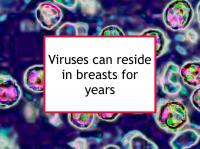The causes of breast cancer include viruses in addition to more well-known factors. The following have been linked to breast cancer: mouse mammary tumor virus (MMTV); bovine leukemia virus (BLV); Epstein-Barr virus; human papilloma virus (HPV ); human cytomegalovirus (Human Herpes virus 5); hepatitis B virus; and measles virus.
Viruses appear to be present more frequently in very young breast cancer patients and inflammatory breast cancer (IBC) cases. Investigation of the relationship between viruses and breast cancer is at an early stage. The topic is controversial, in part because of problems with methodology and inconsistent findings. Now a new study has reported that MMTV, BLV and HPV was found in both the benign breast tissue and breast tumors of the same women years later. In addition, the levels of these viruses was significantly higher in these women than in a control group who never developed breast cancer.
Avoiding childhood exposure to oncogenic viruses
It is not known whether additional exposure to potentially cancer-causing viruses affects prognosis in breast cancer survivors. However, there appears to be an opportunity to reduce breast cancer risk in our daughters and sons by reducing exposure to these viruses. Steps should be taken to avoid transmitting herpes to children during pregnancy or childbirth. Children should be vaccinated against measles as young toddlers and HPV as older children.
Children should not be served raw milk or uncooked beef, both of which are possible sources of BLV infection. Although it is possible that MMTV is more often transmitted between humans rather than passed directly from mice, it makes sense to avoid exposing children to mice, including pet mice.
Viruses found in tumors can be present for years
The Australian study referenced above was designed to investigate the presence of MMTV, BLV, HPV and Epstein Barr virus in women who eventually develop breast cancer. In the study, the authors demonstrate that these viruses can be present in breast tissue years before the development of breast cancer that incorporates the same virus.
To conduct the study, the authors relied, in part, on data they had generated during previous investigations of the four oncogenic viruses. Seventeen women who underwent breast biopsies in which no breast cancer was found one to 11 years prior to developing breast cancer were identified and stored specimens from these patients were obtained. These archival specimens were used in studies of (1) MMTV (known also as human mammary tumor virus (HMTV)) conducted in New York and Pisa, Italy; (2) BLV conducted at UC Berkeley; and (3) HPV and Epstein Barr virus conducted in Sydney, Australia. Breast tissue from cosmetic breast surgery conducted on cancer-free Australian women were used as controls.
The women who served as controls tended to be younger than the women who eventually developed breast cancer.
- BLV was identified in 18 (78%) of 23 pre-cancer tissue specimens and in 20 (91%) of 22 breast tumor specimens from the same women. On the other hand, BLV was found in only 6 (35%) of the 17 control (normal) breast specimens.
- High risk HPV was identified in 13 (72%) of 17 pre-cancer tissue specimens and 13 (76%) of 17 breast tumor specimens from the same women. On the other hand, high risk HPV was found in only 3 (18%) of the 17 control specimens.
- MMTV was identified in 6 (24%) of 25 pre-cancer breast tissue specimens and 9 (36%) of 25 breast tumor specimens from the same women. On the other hand, MMTV was found in only 3 (18%) of the 17 control specimens.
- Epstein Barr virus was not identified in any of 17 pre-cancer tissue specimens but was found in 3 (25%) of 12 breast tumor specimens from the same women. On the other hand, Epstein Barr virus was found in 5 (29%) of the 17 control specimens.
The authors conclude that the findings contribute to the evidence that multiple oncogenic viruses have potential roles in breast cancer. Evidence of prior infection before the development of cancer is a key criterion when assessing causation, according to the authors.
